Legacy of youth protest in China continues in Hong Kong
- Published
Alec Ash is a writer and journalist in Beijing currently writing a book about young Chinese society. Here he discusses young people's historic role in Chinese protest movements.
National Day in China is a jingoistic affair.
Today is the 65th anniversary of when Mao Zedong officially founded the People's Republic of China on 1 October 1949.
There was pomp and circumstance at Tiananmen Square, although no big military parade as for the 60th anniversary.
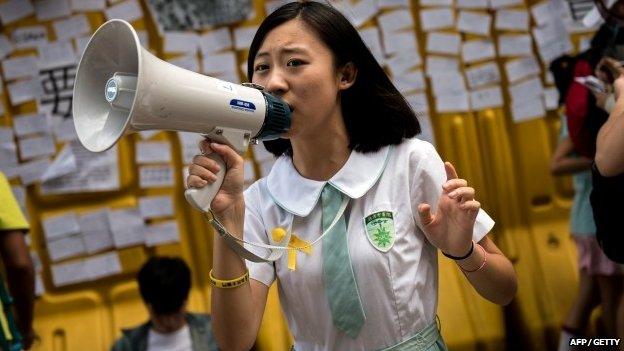
The Hong Kong protests have been noticeable for heavy student involvement
Most ordinary Chinese are busier making plans for the seven days of holiday and spending that clog domestic tourist destinations, earning it the moniker "golden week".
The democracy protests engulfing Hong Kong have given this year's festival a very different flavour.
Beijing nerves
Tens of thousands of protestors, including students, are occupying central areas of Hong Kong to rail against Beijing's vetting of their election candidates, and to voice dissatisfaction with their current leader CY Leung.
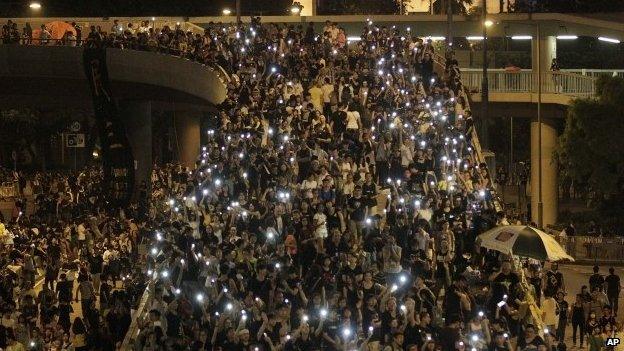
Protesters have warned that if CY Leung, chief executive of Hong Kong, doesn't step down by Thursday, they will occupy key government buildings
China's central leaders now face the first sustained mass movement on Chinese soil with directly political aims since the Tiananmen protests in 1989.
Beijing's nerviness about what these protests might mean to mainland Chinese is evident in their tight control of the story.
State media reports are muted and carefully worded to emphasise "foreign intervention", while mentions of the protests online, such as on the micro blog Weibo, have been rigorously deleted - although the scale of the censorship itself shows that the news is out.
One reason why censors are wary of the movement being picked up on in the mainland is China's historical legacy of youth protest.
Science and democracy
Although 4 June 1989 - the anniversary of the Tiananmen Square Massacre - gets higher billing, the first defining youth movement in modern China was on 4 May 1919.
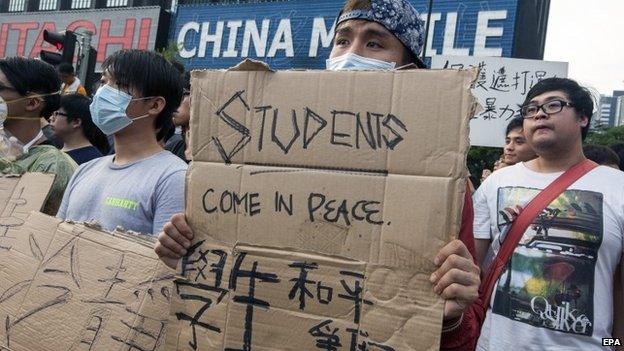
Student protests in China stretch back to 1919
Less than a decade after the Qing dynasty was overthrown by the Xinhai revolution of 1911, students at elite universities in Beijing saw the new Republic of China government as weak, especially in its response to the Treaty of Versailles at the end of World War One.
That afternoon, over 3,000 of them marched to Tiananmen Square to shout slogans. They also burnt the residence of an official they saw as culpable.
Their protest was co-opted into a broader "May Fourth Movement" (fused with a more intellectual cause to reject traditional Confucian culture) that called for radical political changes in China.
The mascots of the movement were "Mr Science" and "Mr Democracy". It was a cause for the young, led in thought by a pioneering magazine called New Youth, and many of the movement's leading lights were active in establishing the Communist Party of China.
Dangers of dissent
As of 1949, 4 May has officially been Youth Day in China, and the Communist Party has appropriated its spirit for their own ends.
In the worst years of Mao Zedong's rule, revolutionary youth had a different meaning - Red Guards, destroying property and assaulting landlords in the name of Mao.
It was only after Mao's death in 1976 that youth protest in China had an anti-government element again, beginning with the "democracy wall" movement of 1978, and picking up momentum in the mid-1980s, until the Tiananmen Spring of 1989.

The Tiananmen Square protests sent a message to many that dissent is dangerous
The student leadership which began the Tiananmen protests in April 1989 never directly called for an overthrow of the Communist Party, but rather for top leaders to step down, and for those more receptive to political reform to take over.
Despite splits within the party, those in power took a hard line against the occupation of Tiananmen Square, ultimately resulting in the bloody crackdown that killed several hundred demonstrators, many of them students.
For the post-Tiananmen generation of youth in China, known as the "post-80s" and "post-90s", such brazen political protest is out of sight and out of mind.
Engagement with politics is largely seen as pointless, or secondary to more daily and personal concerns.
Those who know the full story of the Tiananmen protests understand that dissent is dangerous, and many believe the crackdown was necessary to restore order and pave the way for economic growth - just as many want to see order restored quickly to Hong Kong.
The only place on Chinese soil where the memory of Tiananmen has been kept alive is Hong Kong, where candlelit services are still held every 4 June.
The scale of the current protests has invited comparisons, and the student involvement also rings bells.
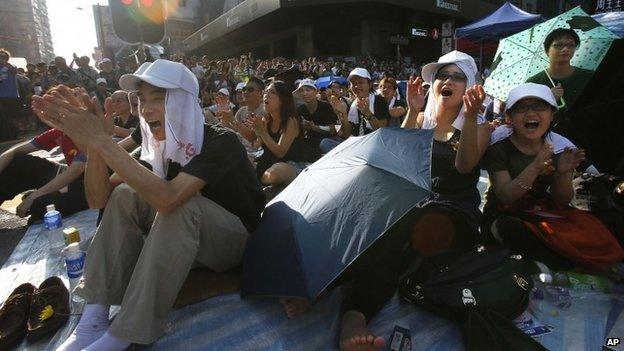
Protesters applaud as they listen to speeches

Protesters clutch umbrellas, a symbol of the ongoing protests
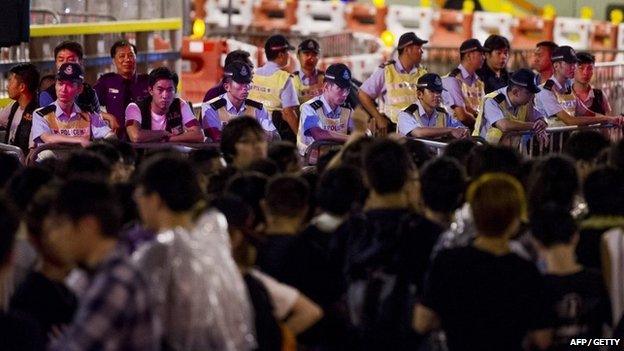
Police watch as protesters gather but there has been no repeat of Sunday's violence
Spirit of revolt
Besides the Occupy movement, it was a student protest group called Scholarism led by 17-year-old Joshua Wong - who had earlier protested against pro-party patriotic education in Hong Kong public schools - that catalysed the occupation with a boycott of classes and a storming of government headquarters.

Joshua Wong (centre) and supporters: Mr Wong has become a key figure in the protests
The protest led to Wong's arrest, although he was released on Sunday.
Occupiers in Hong Kong have local demands, not national, and there is little appetite or chance for a similar movement in mainland China. This is no Tiananmen yet.
But even if the legacy of youth protest in China, from 4 May to 4 June, is hard to find in the mainland unless you dig deep, this shows that the spirit of it is still alive in Hong Kong.